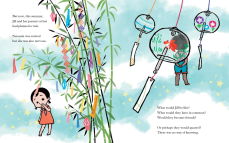Natsumi’s Song of Summer – Robert Paul Weston and Misa Saburi, Tundra Books, 2020

There are many different ways for books to explore the meeting between two children from different cultures, of illuminating the ways in which they are both similar and different. I’m not aware of any others, aside from Natsumi’s Song of Summer, which focus on a specific insect which is familiar to one child but strange to the other. This is the second venture by this author and illustrator featuring a text entirely in the traditional Japanese poetic form of tanka, an entirely successful experiment in unobtrusively introducing young readers to a classic type of literary expression. Words by Robert Paul Weston and pictures by Misa Saburi are perfectly matched in their delicate beauty and sensitivity to the fears and pleasures of childhood.

Natsumi was born during the Japanese summer, when the lovely and richly symbolic lotus flower is in bloom. Saburi’s vision of her sitting on the plant’s petals, suspended in a pond full of carp, captures the mix of realism and dreams which drive the narrative. The unique plant and insect life of her environment are an inseparable part of Natsumi’s life:
There were butterflies
with their striped and spotted wings,
and the sudden sparks
of fireflies, and honeybees
fizzing flower to flower.
The flexibility of the tanka form allows the authors to use the framework of the natural world and the simplicity of a child’s perceptions to create a believable story. Lines composed with a syllable count of five-seven-five-seven-seven (haiku uses three lines of five-seven-five) can convey ideas of great sophistication, or ordinary observations, often both.

When Natsumi learns that her cousin, Jill, will be coming to visit, she is pleased but anxious. Her dream of Jill shows a stranger with her back to Natsumi, who wonders if she and Jill will be to divided by their differences to become close. The image of Jill is placed behind flower-filled lanterns with wind chimes swaying gently around her. Natsumi is worried that her cousin will remain a stranger, facing away from the cherished parts of her own world.

The young Japanese girl has been surrounded by the security of her family, sharing a definition of beauty with them which she is justified in believing may be foreign to her cousin. She particularly questions whether the seasonal arrival of cicadas, which bring the summer with their song, will mean anything to Jill. After all, “Insects frightened some people./What is Jill was frightened, too?”

After Jill arrives, things do change, and they also remain the same. Natsumi explains to her cousin how cicadas “wait in darkness,” until they are old enough to emerge, when “they climb out to meet their friends.” The girls’ summer together is joyous and fun. Ordinary activities, drawing, enjoying ice cream, playing outdoors, are enhanced by the realization that they are learning from one another.

Outdoor scenes are marked by light, while the girls sketch indoors in semi-darkness and the artificial cool air of an electric fan. While Natsumi draws cicadas, Jill produces an image of a Luna moth, as exotic to Natsumi as its Japanese counterpart is to her American cousin: “Elegant green wings/with two black-and-yellow spots/like half-winking eyes.”
At the Obon festival, the girls share the festivities surrounding the rituals marking connections to one’s ancestors. Both girls are dressed in kimonos, with Jill naturally integrated into the exciting occasion. In a line of women, Natsumi turns around to face her cousin, her face half in light and half in darkness. She seems to be reassuring herself that Jill is sharing in her delight.

Natsumi’s Song of Summer needs to be experienced in its totality in order to fully appreciate the accomplishment of this author and illustrator team. Like the unity of tanka itself, each page each picture and line of text, is an unforgettable poem celebrating the value of the transient and seasonal, along with the deep and permanent mark these moments and relationships bring.

One thought on “Seasons of Friendship”